How to Plant Zinnias
- April 5, 2024
- 0 comment
Zinnias, with their vibrant colors and easy-to-grow nature, are a popular choice for gardeners looking to add life and color to their gardens. Whether you’re an experienced gardener or a beginner, zinnias offer a delightful way to brighten your outdoor space. This article provides a comprehensive guide on how to plant and care for these cheerful blooms.
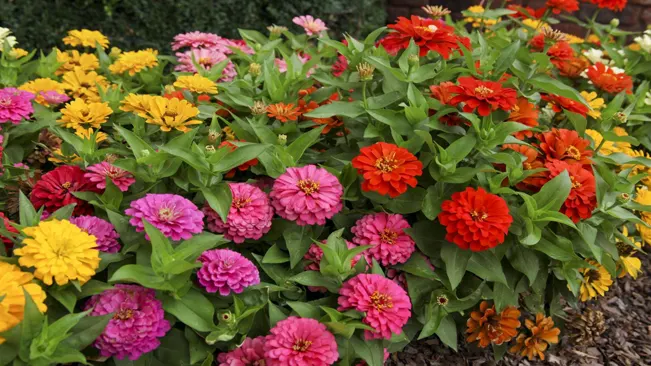
List on How To Plant Zinnias
- Choosing Your Zinnias
- When to Plant Zinnias
- Soil Preparation For Zinnias
- Planting Seeds or Seedlings
- Watering and Fertilizing
- Pest and Disease Management
- Deadheading and Pruning
- Maximizing Zinnia Blooms for Cutting
Choosing Your Zinnias
Zinnias, with their diversity in size, color, and shape, are a favorite among gardeners who desire vibrant and dynamic gardens. Understanding the different varieties and what each offers can help you make the best choice for your garden.
Variety and Size
Zinnia elegans

- Often referred to as the common zinnia, ‘Zinnia elegans’ is a popular species known for its wide range of colors and large, showy blooms. It typically grows to about 1-3 feet in height.
‘Zahara’ Series
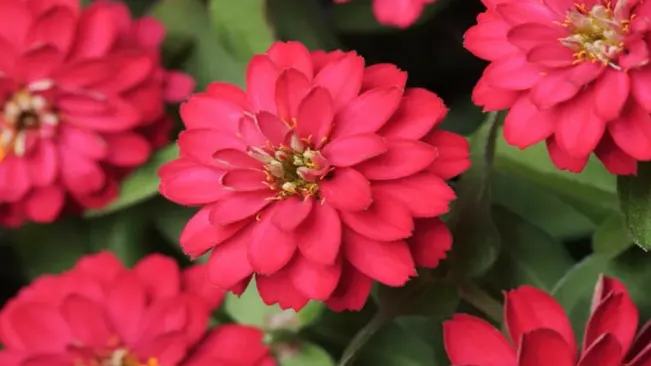
- These are known for their disease resistance, particularly to mildew, which can be a common problem in zinnias. The ‘Zahara’ series presents a compact growth habit, usually not exceeding 12-18 inches in height. They produce vibrant, single or double flowers.
‘Profusion’ Series
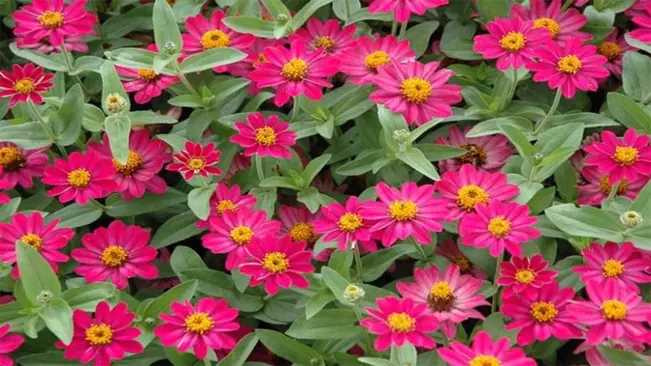
- A cross between ‘Zinnia angustifolia’ and ‘Zinnia elegans,’ the ‘Profusion’ series is celebrated for its profuse blooming and disease resistance. These plants are smaller and more compact, typically around 12-18 inches tall.
Flower Size and Color
- Large Blooms: Varieties like ‘Zinnia elegans’ often have larger blooms, which can be ideal for creating focal points in your garden or for cut flower arrangements.
- Smaller Blooms: Varieties like ‘Profusion’ and ‘Zahara’ have smaller, but abundant flowers, creating a blanket of color. They are excellent for borders or as ground cover.
- Color Range: Zinnias are available in almost every imaginable color except true blue. This includes vibrant reds, oranges, pinks, yellows, whites, and purples. Some varieties even offer bi-colored blooms.
Garden Design Considerations
- Height and Structure: Taller varieties like certain types of ‘Zinnia elegans’ are great for the back of garden beds or as stand-alone features. Shorter varieties can line walkways or form borders.
- Color Coordination: Consider the existing colors in your garden. Zinnias can be used to complement or contrast these colors. For a harmonious look, choose colors that are adjacent on the color wheel. For a vibrant, eye-catching display, select colors that are opposite each other on the color wheel.
- Growing Conditions
- While the specific care might slightly vary between varieties, most zinnias thrive in well-drained soil, full sun, and regular watering. They are generally quite hardy and adaptable.
When to Plant Zinnias
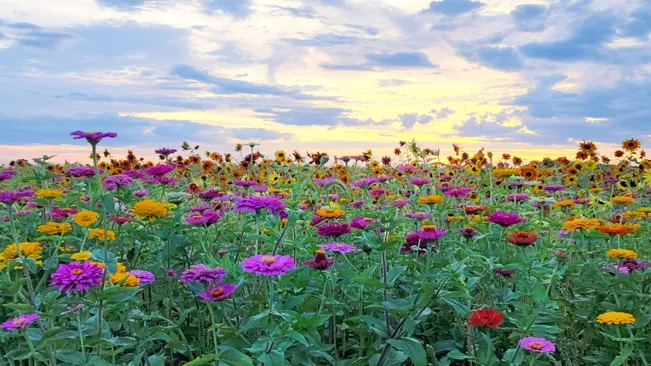
- Why Post-Frost Planting is Crucial: Zinnias are warm-weather annuals, meaning they complete their life cycle in one growing season and are sensitive to cold temperatures. Planting them after the last frost date ensures that the young plants are not exposed to damaging cold weather, which can stunt growth or even kill the plant.
- Identifying the Last Frost Date: The last frost date varies depending on geographic location. You can find this information through local gardening clubs, agricultural extension offices, or online resources that track climatic conditions. It’s usually in late spring or early summer for most regions.
- Optimal Temperature for Zinnia Growth: Zinnias germinate best in soil temperatures between 70 to 85 degrees Fahrenheit (21 to 29 degrees Celsius). These temperatures typically occur in late spring in many regions, aligning with the ideal planting time.
- Considering Regional Variations: In warmer climates, such as the southern United States, you might be able to plant zinnias earlier than in cooler northern areas. Conversely, in cooler climates, you may need to wait until mid or late summer for optimal planting conditions.
- The Role of Sunlight: Zinnias require a lot of sunlight – at least 6 to 8 hours of direct sunlight daily. Planting them when the days are longer ensures they receive enough light to grow strong and healthy.
- Soil Preparation: Well-drained soil is vital for zinnias to prevent root rot and other moisture-related diseases. Prepare your garden bed by loosening the soil and incorporating organic matter or compost to improve drainage and soil fertility.
- Advantages of Seasonal Planting: Planting zinnias in the recommended period maximizes their growth period before the first fall frost. This leads to a longer blooming season, allowing you to enjoy their vibrant colors for an extended time.
Soil Preparation For Zinnias
Zinnias, though not overly demanding in their soil requirements, flourish in conditions that support robust growth and vibrant blooms. Here are key points to consider for optimal soil preparation:
- Soil Quality
- Richness: Zinnias thrive in nutrient-rich soil. This can be achieved by incorporating organic matter such as compost, well-rotted manure, or leaf mold into the soil. These amendments improve the soil structure, enhance nutrient content, and support healthy plant growth.
- Drainage: Good drainage is crucial for zinnias. They do not like to sit in waterlogged soil, which can lead to root rot. If your garden has heavy clay soil, consider amending it with sand or fine gravel to improve drainage.
- Soil pH
- Zinnias prefer a neutral to slightly acidic soil pH, typically between 5.5 and 7.5. If you are unsure about your soil’s pH, you can test it with a home test kit available at most garden centers. Adjust the pH if necessary using lime to raise it or sulfur to lower it.
- Fertilization
- While zinnias are not heavy feeders, providing them with a balanced, slow-release fertilizer at planting can promote healthy growth. Look for a fertilizer with an equal balance of nitrogen, phosphorus, and potassium (e.g., 10-10-10). Avoid high-nitrogen fertilizers, as they can promote leaf growth at the expense of blooms.
- Weed Control
- Clearing the area of weeds before planting is essential. Weeds compete with zinnias for nutrients, water, and light. Remove weeds manually or use a hoe, taking care not to disturb the soil too deeply, which might bring dormant weed seeds to the surface.
- Soil Loosening
- Loosen the soil to a depth of about 6 to 8 inches. This aeration allows the zinnia roots to penetrate deeply and spread easily. It also helps improve drainage and makes it easier for roots to access nutrients.
- Mulching
- After planting, consider applying a layer of organic mulch around the zinnias. Mulch helps retain moisture, suppresses weeds, and gradually enriches the soil as it decomposes.
Planting Seeds or Seedlings
If planting seeds directly in the garden, sow them about ¼ inch deep and space them according to the variety’s size. For seedlings, dig a hole slightly larger than the root ball and place the plant gently, covering the roots with soil. Water thoroughly after planting.
Planting Zinnia Seeds
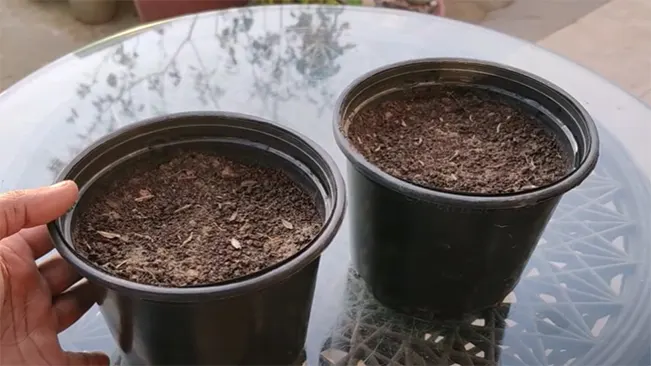
- Timing: Plant zinnia seeds directly in the garden after the danger of frost has passed and the soil has warmed. Zinnias germinate best in warm soil temperatures, ideally around 70-75°F (21-24°C).
- Seed Depth and Spacing: Sow zinnia seeds about ¼ inch deep. The spacing depends on the variety of zinnia you are planting. Smaller varieties can be spaced about 4-6 inches apart, while larger varieties may need 12-24 inches. Proper spacing helps ensure adequate air circulation, which is vital for preventing fungal diseases.
- Soil Preparation: Prepare your garden bed by loosening the soil and removing any weeds or debris. Zinnias prefer well-drained soil. Adding organic matter or compost can help enrich poor soil.
- Watering: After sowing the seeds, water the soil gently but thoroughly. Keep the soil consistently moist but not waterlogged until germination, which typically occurs within 7-10 days.
- Thinning Seedlings: Once the seedlings have a few sets of true leaves, thin them to the appropriate spacing for their variety. This ensures that each plant has enough room to grow and reduces competition for nutrients and water.
Planting Zinnia Seedlings
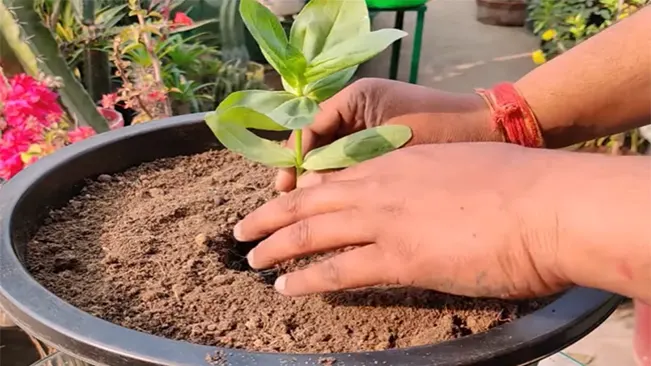
- Transplant Timing: If you’re starting zinnias indoors or have purchased seedlings, wait until all risk of frost is past and the seedlings are strong enough to handle the transplant.
- Hole Preparation: Dig a hole for each seedling that is slightly larger than the root ball. This gives the roots room to expand and makes it easier for them to adjust to the new soil.
- Planting Depth: Place the seedling in the hole at the same depth it was growing in its previous container. Burying the stem too deep can cause it to rot, while planting it too shallow can stress the plant.
- Soil Contact: Gently firm the soil around the roots to ensure good contact but avoid compacting it, as this can hinder root growth and water penetration.
- Watering After Planting: Water the seedlings thoroughly after planting. This helps settle the soil around the roots and eliminates air pockets.
- Post-Planting Care: Keep the soil around the seedlings moist but not waterlogged. Mulching around the plants can help retain moisture and suppress weeds.
Watering and Fertilizing
Water zinnias deeply a few times a week, allowing the soil to dry out between watering. Overwatering can lead to fungal diseases. A monthly dose of balanced, water-soluble fertilizer can encourage robust growth and vibrant blooms.
Watering Zinnias
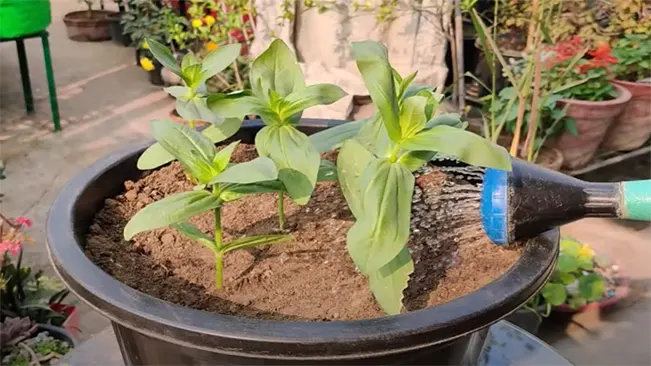
- Frequency and Depth: Zinnias require deep, thorough watering a few times a week. The goal is to ensure water reaches the roots, encouraging deep root growth which in turn supports healthier plants. The exact frequency depends on your climate and weather conditions. In hotter, drier climates, you may need to water more frequently.
- Checking Soil Moisture: Before watering, check the soil moisture. The soil should be dry an inch below the surface. Overwatering can be just as harmful as underwatering. Zinnias are somewhat drought-tolerant and can handle short dry spells.
- Watering Technique: When watering zinnias, aim to water at the base of the plants. Avoid overhead watering as much as possible. Wetting the foliage can increase the risk of fungal diseases like powdery mildew, which zinnias are prone to.
- Mulching: Consider using mulch around your zinnias. Mulch helps retain soil moisture and reduces the frequency of watering needed. It also helps to keep the soil cool and reduces weed growth.
Fertilizing Zinnias
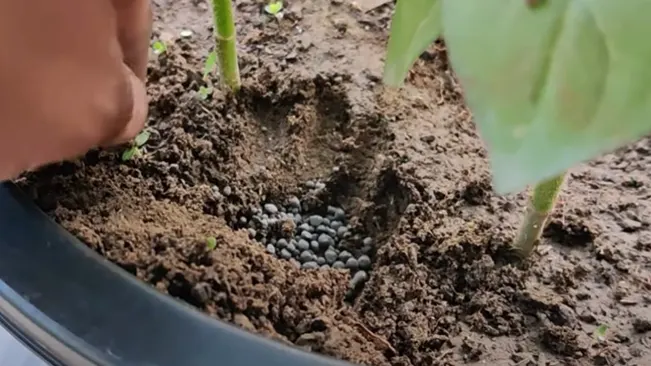
- Type of Fertilizer: Use a balanced, water-soluble fertilizer for zinnias. Balanced fertilizers typically have equal or similar ratios of nitrogen, phosphorus, and potassium (N-P-K), such as 10-10-10 or 20-20-20.
- Frequency of Application: Fertilizing once a month is generally sufficient. Over-fertilizing can lead to lush foliage at the expense of blooms, so it’s important to follow the recommended application rates on the fertilizer package.
- Application Method: Apply the fertilizer according to package instructions, typically by mixing it with water and applying it to the base of the plants. This method helps the nutrients reach the roots more effectively.
- Organic Options: If you prefer organic gardening, compost or organic fertilizers can be excellent alternatives. These natural options release nutrients slowly and improve soil health over time.
Pest and Disease Management
Insect Pests: Aphids and Spider Mites
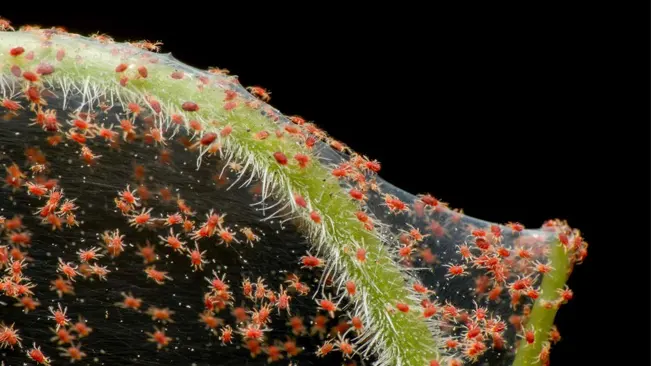
- Aphids:
- Identification: Small, pear-shaped insects that can be green, black, brown, or red. They cluster on new growth and undersides of leaves.
- Damage: Aphids suck sap from plants, causing leaves to curl, wilt, or yellow. They also excrete a sticky substance called honeydew, which can lead to sooty mold.
- Management: A strong jet of water can dislodge aphids from plants. Insecticidal soaps or neem oil sprays are effective if applied thoroughly. Encouraging beneficial insects like ladybugs, which prey on aphids, can also help.
- Spider Mites:
- Identification: Tiny, spider-like mites, often red or brown, visible as fine webs on the underside of leaves.
- Damage: They cause yellowing or bronzing of leaves and can lead to leaf loss and reduced plant vigor.
- Management: Increase humidity around plants as spider mites thrive in dry conditions. Use insecticidal soap or neem oil. Regular monitoring and cleaning of leaves can prevent severe infestations.
Fungal Diseases: Powdery Mildew
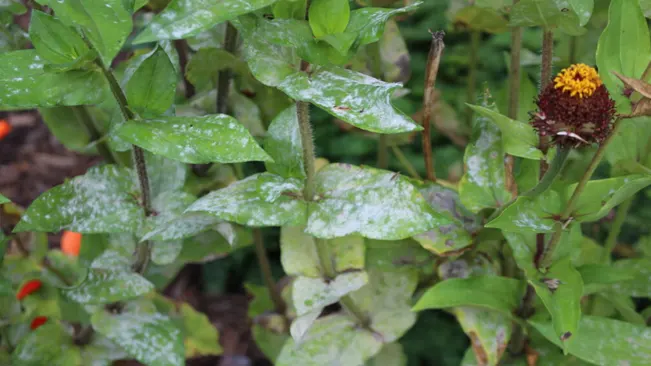
- Powdery Mildew
- Identification: Appears as white, powdery spots on leaves and stems. It typically does not kill plants but can weaken them and reduce flowering.
- Conditions: It thrives in humid conditions with moderate temperatures.
- Prevention and Control:
- Circulation: Ensure good air circulation around your zinnias by not overcrowding them and pruning any dense foliage.
- Watering: Water plants at the soil level to avoid wetting leaves, and water in the morning so foliage dries during the day.
- Fungicides: For severe cases, fungicides can be effective. Organic options include baking soda mixes or sulfur-based fungicides.
- Resistant Varieties: Consider planting mildew-resistant varieties of zinnias.
Deadheading and Pruning
Deadheading Zinnias
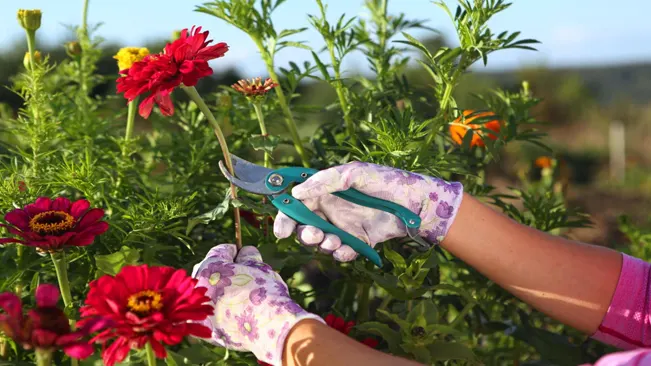
- What is Deadheading?: Deadheading involves removing faded or spent blooms. This process is important because it prevents zinnias from putting energy into seed production, which can decrease overall flowering.
- How to Deadhead: To deadhead, simply cut or pinch off the flower stem below the spent flower and above the next set of leaves. It’s best to use clean, sharp scissors or pruning shears.
- Frequency: Regularly check your plants, at least once a week, and deadhead as needed. During peak blooming season, you might need to do this more frequently.
- Benefits: This process encourages the plant to produce more blooms and can extend the flowering season. It also keeps the plants looking tidy and can prevent disease by removing potential decay.
Pruning Zinnias

- What is Pruning?: Pruning involves cutting back parts of the plant to improve its shape, encourage growth, or remove unhealthy parts.
- When to Prune: If your zinnia plants become tall and leggy or seem to be overgrown, it’s a good sign that they need pruning.
- How to Prune: Use clean, sharp pruning shears to cut back the stems. You can cut back up to one-third of the plant’s height. Make the cuts just above a leaf node or bud.
- Encouraging Bushier Growth: Pruning can stimulate the plant to grow more stems, which results in a fuller, bushier plant and potentially more flowers.
- Revitalizing Plants: Mid to late summer, when the plant has been blooming for a while and might start looking a bit tired, is a good time for a more significant pruning to revitalize the plant.
Maximizing Zinnia Blooms for Cutting
Zinnias are not just a delight in the garden; they are also standout stars in floral arrangements. Their long stems and a wide range of vibrant colors make them ideal as cut flowers. Here’s how to maximize your zinnia blooms for cutting and arrangement

- Timing the Cut Cut zinnias in the morning when their stems are filled with water and the blooms are less likely to wilt. Choose blooms that are almost fully open, as zinnias will continue to open after being cut.
- Selecting the Right Stems Look for stems that are firm and not limp. Avoid stems that show signs of wilting, yellowing, or pest damage.
- Cutting Technique Use a sharp pair of garden scissors or pruners to make a clean cut. Cut the stems at an angle to increase the surface area for water intake.
- Immediate Care After cutting, immediately place the stems in a bucket of warm water. This helps to keep the flowers hydrated and prevents wilting.
- Prepping for Arrangement Before arranging, remove any leaves that will be below the waterline in your vase. This prevents bacterial growth in the water, which can shorten the life of your blooms.
- Arranging Your Zinnias Zinnias work well with a variety of other flowers, but they can also stand alone in a vase. Their bold colors and shapes make them versatile for both formal and informal arrangements.
- Water and Vase Care Change the water in the vase every two days and re-cut the stems at an angle to ensure longevity. This keeps the flowers fresh and vibrant for a longer time.
- Encouraging More Blooms Regularly cutting zinnias for bouquets encourages the plant to produce more flowers. It’s a beneficial cycle – the more you cut, the more they bloom.
Conclusion
Planting zinnias is a joyful and rewarding gardening activity. With minimal care, these bright and cheerful flowers can add a burst of color to your garden all summer long. Whether in garden beds, borders, or containers, zinnias will bring life and vibrancy to your outdoor space.
FAQs (Frequently Asked Questions)
- When is the best time to plant zinnias?
The ideal time to plant zinnias is after the last frost in spring, as they thrive in warm weather and cannot tolerate frost. - Can I plant zinnias in partial shade?
Zinnias prefer full sun for at least 6-8 hours a day. While they can tolerate partial shade, they may not bloom as prolifically. - How deep should I plant zinnia seeds?
Plant zinnia seeds about ¼ inch deep in the soil. - How far apart should I space zinnias?
Spacing depends on the variety, but generally, zinnias should be spaced 4-24 inches apart, with larger varieties needing more space. - Do zinnias need a lot of water?
Zinnias require moderate watering. Water them deeply a few times a week, allowing the soil to dry out between waterings. - What kind of soil is best for zinnias?
Zinnias prefer well-drained soil rich in organic matter. They are adaptable but thrive in soil with a neutral to slightly acidic pH. - Do I need to fertilize zinnias?
While zinnias aren’t heavy feeders, applying a balanced, water-soluble fertilizer monthly can promote healthier blooms. - How do I prevent pests and diseases in zinnias?
Ensure good air circulation, avoid overwatering, and remove any affected leaves. For pests like aphids, use insecticidal soap or neem oil. - Can I grow zinnias in containers?
- Yes, zinnias can be grown in containers. Ensure the container is large enough and has good drainage.
- Why are my zinnias not blooming?
This could be due to inadequate sunlight, too much nitrogen in the soil, or a lack of pruning. Ensure they get enough sun, balance your soil nutrients, and regularly deadhead spent flowers.

Emma Hudson
Forestry AuthorEmma's experience in farming shapes her detailed guides on gardening and farming tools, providing practical, actionable advice grounded in real-world experience. Her work targets both newcomers and experienced farmers, aiming to enhance their practices with a mix of traditional wisdom and modern techniques. By making complex agricultural concepts accessible, Emma's guides serve as valuable tools for those navigating the challenges of contemporary farming, offering strategies for sustainable success.













Leave your comment